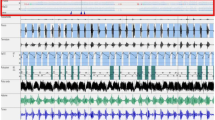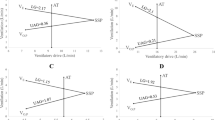Abstract
Purpose
Although currently there are simplified methods to measure the pathophysiological traits that stimulate the occurrence and maintenance of obstructive sleep apnea–hypopnea (OSAH), they remain difficult to implement in routine practice. This pilot study aimed to find a simpler daytime approach to obtain a meaningful, similar pathophysiological phenotypic profile in patients with OSAH.
Methods
After obtaining diagnostic polygraphy from a group of consecutive patients with OSAH, we performed the dial-down CPAP technique during nocturnal polysomnography and used it as reference method. This allowed assessment of upper airway collapsibility, loop gain (LG), arousal threshold (AT), and upper airway muscle gain (UAG). We compared these results with a daytime protocol based on negative expiratory pressure (NEP) technique for evaluating upper airway collapsibility and UAG, on maximal voluntary apnea for LG, and on clinical predictors for AT.
Results
Of 15 patients studied, 13 patients with OSAH accurately completed the two procedures. There were strong (all r2 > 0.75) and significant (all p < 0.001) correlations for each phenotypic trait between the measurements obtained through the reference method and those achieved during wakefulness.
Conclusion
It is possible to phenotype patients with OSAH from a pathophysiological point of view while they are awake. Using this approach, cutoff values corresponding to those usually adopted using the reference method can be identified to detect abnormal traits, achieving profiles similar to those obtained through the dial-down CPAP technique.





Similar content being viewed by others
Data availability
Not Applicable
Code availability
Not Applicable
References
Martinez-Garcia MA, Campos-Rodriguez F, Barbè F, Gozal D, Agusti A (2019) Precision medicine in obstructive sleep apnea. Lancet Respir Med 7:456–464
Uccelli S, Pini L, Bottone D, Ranieri P, Orzes N, Tantucci C (2020) Dyspnea during night-time and at early morning in patients with stable COPD is associated with supine tidal expiratory flow limitation. Int J Chron Obstruct Pulmon Dis 15:2549–2558
Taranto-Montemurro L, Messineo L, Perger E, Salameh M, Pini L, Corda L, Ferliga M, Tantucci C (2016) Cardiac sympathetic hyperactivity in patients with chronic obstructive pulmonary disease and obstructive sleep apnea. COPD 13(6):706–711
Quadri F, Boni E, Pini L, Bottone D, Venturoli N, Corda L, Tantucci C (2017) Exercise tolerance in obstructive sleep apnea-hypopnea (OSAH), before and after CPAP treatment: effects of autonomic dysfunction improvement. Respir Physiol Neurobiol 236:51–56
Eckert DJ, White DP, Jordan AS, Malhotra A, Wellman A. Defining phenotypic causes of obstructive sleep apnea. Identification of novel therapeutic targets. Am J Respir Crit Care Med 2013; 188:996–1004.
Malhotra A, Mesawi O, Pepin JL, Owens RL (2020) Endotypes and phenotypes in obstructive sleep apnea. Curr Opin Pulm Med 26:609–614
Messineo L, Magri R, Corda L, Pini L, Taranto-Montemurro L, Tantucci C (2017) Phenotyping-based treatment improves obstructive sleep apnea symptoms and severity: a pilot study. Sleep Breath 21(4):861–868
Deacon NL, Jen R, Li Y, Mallhotra A. Treatment of obstructive sleep apnea. Prospects for personalized combined modality therapy. Ann Am Thorac Soc 2016; 13:101–108.
Taranto-Montemurro L, Messineo L, Wellman A. Targeting endotypic traits with medications for the pharmacological treatment of obstructive sleep apnea. A review of the current literature. J Clin Med 2019; 8: 1846.
Lim R, Messineo L, Grunstein RR, Carberry JC, Eckert DJ (2021) The noradrenergic agent reboxetine plus the antimuscarinic hyoscine butylbromide reduces sleep apnoea severity: a double-blind, placebo-controlled, randomized crossover trial. J Physiol 599:4183–4195
Perger E, Taranto-Montemurro L, Rosa D et al. Reboxetine plus Oxybutinin for obstructed sleep apnea treatment. A 1-week randomized, placebo-controlled, double-blind, crossover trial. Chest 2021; in press.
Wellman A, Edwards BA, Sands SA et al (1985) A simplified method for determining phenotypic traits in patients with obstructive sleep apnea. J Appl Physiol 2013(114):911–922
Sateia MJ (2014) International classification of sleep disorders-third edition: highlights and modifications. Chest 146:1387–1394
Rosenberg RS, Hout SV (2014) The American Academy of Sleep Medicine Inter-scorer Reliability Program: respiratory events. J Clin Sleep Med 10:447–454
Taranto-Montemurro L, Bettinzoli M, Corda L, Braghini A, Tantucci C (2010) Relationship between critical pressure and volume exhaled during negative pressure in awake subjects with sleep-disordered breathing. Chest 137:1304–1309
Hirata RP, Schorr F, Kayamori F et al (2016) Upper airway collapsibility assessed by negative expiratory pressure while awake is associated with upper airway anatomy. J Clin Sleep Med 12:1339–1346
Tantucci C, Mehiri S, Duguet A et al (1985) Application of negative expiratory pressure during expiration and activity of genioglossus in humans. J App Physiol 1998(84):1076–1082
Messineo L, Taranto-Montemurro L, Azarbazin A et al (2018) Breath-holding as a means to estimate the loop gain contribution to obstructive sleep apnea. J Physiol 596:4043–4056
Edwards BA, Eckert DJ, McShurry DG et al (2015) Clinical predictors of the respiratory arousal threshold in patients with obstructive sleep apnea. Am J Respir Crit Care Med 190:1293–1300
Terrill PI, Edwards BA, Nemati S et al (2015) Quantifying the ventilatory control contribution to sleep apnoea using polysomnography. Eur Respir J 45:408–418
Sands SA, Terrill PI, Edwards BA et al (2018) Quantifying the arousal threshold using polysomnography in obstructive sleep apnea. Sleep 41:1–9
Sands SA, Edwards BA, Terrill PI et al (2018) Phenotyping pharyngeal pathophysiology using polysomnography in patients with obstructive sleep apnea. Am J Respir Crit Care Med 197:1187–1197
Hirata RP, Kayamori F, Schorr F et al (2017) Influence of interface and position on upper airway collapsibility assessed by negative expiratory pressure. Sleep Breath 21:631–638
Acknowledgements
The Authors acknowledge Mr. M. Guerini and Mr. L. Pedroni, University Lab. technicians, for their invaluable technical support.
Author information
Authors and Affiliations
Contributions
Study design: CT and LP. Data collection: RM, GL, LZ. Data analysis: EP and LP. Interpretation of results: all authors. Initial draft: CT. Review of the manuscript for intellectual content: all authors.
Corresponding author
Ethics declarations
Ethics approval
The study was performed in accordance with the Helsinki declaration and was approved by the University of Brescia's Department of Clinical and Experimental Science (DSCS) Ethic Committee.
Consent to participate
All participants signed written informed consent upon enrolling.
Consent for publication
All participants signed written consent for publication upon enrolling.
Competing interests
The authors declare no competing interests.
Additional information
Publisher's Note
Springer Nature remains neutral with regard to jurisdictional claims in published maps and institutional affiliations.
Rights and permissions
About this article
Cite this article
Pini, L., Magri, R., Perger, E. et al. Phenotyping OSAH patients during wakefulness. Sleep Breath 26, 1801–1807 (2022). https://doi.org/10.1007/s11325-021-02551-5
Received:
Revised:
Accepted:
Published:
Issue Date:
DOI: https://doi.org/10.1007/s11325-021-02551-5




